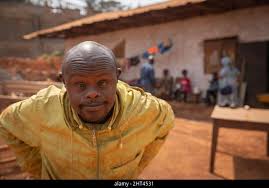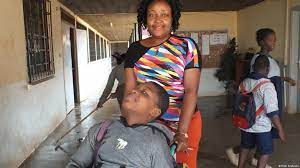Disability Stigma in Developing Countries
- kcebma
- Dec 19, 2022
- 5 min read
I am an african and a cameroonian. Growing up people with disablities were never talked about or given the time of the day, come to think of it i had never had an ecounter with a disable perosn or really ever thought about them or given the word 'disabilty' and how it was percieved as a whole in my country. I travled out of the country and boom , it was all in my face ! Whole campaigns dedicated for disable people. They even had a voice. People were talking about them . Set charities were educating the society about how to support them! I mean they are treated with such dignity and even had priority seats on buses , trains and trams! I was blown away and eventually i did some study and became a nurse and got proper eduction on disablity while at uUniverisy. When i went home for a visit i had my first encounter with the stigma surrounding people living with disablity and i completely understood what these people were going through with people having very little knowledge on what to or support their loved ones with a disablity. After that encounter, i decided to go on and do an MSc in Mental Health and disablility, this so i could better understand how to give back to my communiity and help dispell the stigma surround disablity in my home country. Also use it as a tool to better educate and empower my local community on how to support people with disablity .
Read my story .

It began with one encounter......
During one of my trips home after about a few years aborad, we often visited different cultural sites during the weekend. One particular weekend, we visited this art school in Cameroon and I looked forward to seeing the studio and get some art work for myself and friends. What I did not expect to see was a young boy with a mental disability/disability in his hand. When we arrived and climbed out of the bus, he was there to greet us. One could tell he had a mental disability but it was not visible what kind. I went to take a photo by a nearby mural and he joined. From that point on, he was my shadow for the day. As we walked to the first building, I could tell he had urinated and vomited on himself. Thinking he must live there, I took the hand he offered as we left to see the school facilities, hoping that someone could help him clean himself. However, it became evident as we had our tour that he was often around the center but did not live there. The host siblings on the trip pointed at him as they kept their distance. Once we arrived at the gallery, he became more and more animated as he realized the attention he could get from the other children by chasing them. No one seemed to know what to do with him. It became a tense situation when he even chased students around the gallery full of fragile art pieces. As we took the bus to leave, he blocked the entrance and tried to grab hold of students. It was only when our tour guide took hold of him that we could enter to depart. The situation upset and unsettled me. Who was he? Where was he from? Why was no one taking care of him? And why was everyone so afraid? I had already determined to study persons with disabilities because of several experiences in the united Kingdom working with adults with mental disabilities but this encounter made me curious to know more specifically the state of persons with mental disabilities in Cameroon.
What are the core drivers behind stereotypes, prejudice (including pity/shame etc), and harmful practices against persons with disabilities in developing countries.
what promising strategies/pathways for addressing these drivers have been identified?
some Key findings about the drivers of disability stigma.
Lack of understanding and awareness regarding the causes of disabilities and their resulting characteristics is a key factor in the stigma experienced by people with disabilities.
Misconceptions about the cause of disabilities often result from cultural or religious beliefs. Disability is often blamed on: misdeeds of ancestors; misdeeds of parents; misdeeds of the person with disabilities; supernatural forces such as demons/spirits; witchcraft; or punishment or fate from God.
As a result people with disabilities may be thought to be not quite human or a source of shame, which has serious consequences for how they are treated.
Misconceptions about the nature and abilities of people with disabilities, including that they are unable to contribute financially; that they are not able to have a normal relationship; that they will be unable to report sexual abuse; that their disability is contagious or they bring bad luck; that their bodies have magical powers; or that they are witches, also contribute to the stigma, discrimination and abuses they experience.
Discriminatory legislation and policies reinforce prejudice and discrimination, while the segregation of people with disabilities perpetuates negative stereotypes.
I found out that Attitudes towards disability are not the same within countries, communities, or even families.
Different types of impairments carry different levels of stigma, as does the severity of the impairment and how it was acquired. People with intellectual disabilities, severe mental health conditions, albinism, and sensory disabilities are often more stigmatised than people with physical disabilities.
People with disabilities who can participate in their communities experience less stigma than those with more severe disabilities.
Females who are disabled are doubly disadvantaged, due to the stigma associated with gender as well as disability.
Socio-economic status can affect attitudes towards disability.
People with disabilities in rural areas may experience more harmful practices than in urban areas.
False perceptions and beliefs about disability are often difficult to overcome, but they can change and evolve over time, especially when interventions aimed at addressing disability stigma are implemented. Much of the available information on promising strategies for addressing disability stigma appears to focus on efforts to reduce the stigma experienced by people with intellectual disabilities but is applicable more widely.
Interventions at the intrapersonal and familial level include self-help, advocacy and support groups, which have generally been found to be effective to some extent. The empowerment of people with disabilities is especially important for overcoming internalised stigma and stigma more generally.
It is important for families of children with disabilities to actively nurture their child’s development; to include them in the community; spread information to counter myths and superstitions about disability; and advocate on their behalf.
Parent and friends associations can be an important strategy for addressing stigma in developing countries.
Interpersonal interventions generally involve education (aiming to challenge inaccurate stereotypes by providing factual information) or contact (encouraging positive interactions between the public and persons with disabilities). Education interventions are reported to have had mixed efficacy, while contact has shown a lot of promise as a stigma reduction strategy, especially if it starts at an early age. It might be most useful to combine contact based approaches with education.
Community based rehabilitation; village gatherings to communicate messages on disabilities in a way that harmonises with local cultural values and activities; and support from community leaders have been suggested as strategies especially suited to reducing disability stigma in developing countries.
Interventions at the governmental/structural level including legislation to tackle disability discrimination; mass media campaigns; reporting and documenting of abuses; and advocacy are important for tackling disability sigma.
Conclusively, i soon found out on this seach for more knowledge on stigma surrundong disability and that tacking disability stigma is challenging because reactions to it are compounded by other social attitudes (to women, ethnic and religious minorities) and by poverty, which needs to be taken into account. Approaches also need to be tailored to the variations in understanding and perceptions of disability that exist within and across countries.

